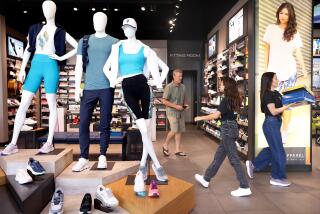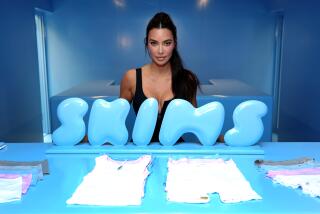K-Swiss Dips a Toe in Europe : Shoes: The Pacoima firm takes a no-frills approach in marketing its sneakers. With U.S. market growth slowing, it must look overseas.
- Share via
In the fashion-craze U.S. sneaker market, K-Swiss Inc. is an anomaly. Eschewing glitz and glamour, the Pacoima-based firm has instead relied largely on one plain, white 26-year-old tennis shoe. No superstar endorsements. No sexy television ads.
The strategy has worked.
It’s also helped that the domestic sport shoe market surged in the past five years, averaging 15% growth annually. And a rising tide lifts all boats, including K-Swiss, where sales grew from $22 million in 1986 to $119 million last year. Through nine months of this year its revenue climbed 8% to $107 million, while profits were up 14% to $8.5 million.
Although K-Swiss has only 1.6% of the $5.8-billion U. S. sneaker market--and its market share hasn’t budged since 1989--the company is content to grow as a tiny niche player, along with such brands as New Balance, Etonic and British Knights.
But now, with the U. S. athletic-shoe market softening, K-Swiss is taking its strategy to Europe--where sneaker sales are growing rapidly, fueled by that continent’s fascination with American lifestyles.
However, K-Swiss is off to a slow start. Steven Nichols, the company’s chairman and president, concedes that K-Swiss’ sales in Europe are tiny.
One reason K-Swiss is already behind is that Nike and Reebok--which control 55% of the U. S. athletic shoe market--made their foray into Europe several years ago. Those two companies, along with Germany-based Adidas, control the bulk of the European athletic footwear market.
In Europe, K-Swiss lacks their brand awareness. There is less room for an avalanche of different brands on store shelves and distribution channels are more fragmented because there are fewer sports goods chains than in the U. S.
Yet as in the United States, Nichols hopes to succeed in Europe by avoiding clashes with industry titans. K-Swiss would be “very happy” to be a tiny niche player in Europe, he said. If K-Swiss could duplicate its 1.6% U. S. market share in Europe, it would double its revenue.
But analysts say that won’t be easy. For one thing, K-Swiss isn’t well known in Europe. “Brand awareness is the key if you’re in the foreign market,” said Mark Goldston, president and chief operating officer of L. A. Gear, which, like K-Swiss, opened a sales and marketing office in London last year.
While some analysts suggest K-Swiss must do well in Europe to maintain its sterling growth, Nichols disagrees. “Yes, the U. S. market has slowed down,” he said. “But the U. S. is such a big market that superior performance can still give us great growth, especially given our small size.” Nichols added that opportunities also exist in Asia, Africa, Australia and South America.
Nichols says K-Swiss’ push into Europe is part of a broader global emphasis that also includes shifting production from South Korea and Taiwan--where shoe workers’ pay has risen to about $3 an hour--to lower-wage countries such as Indonesia and mainland China. Nichols eventually plans to sell K-Swiss shoes to China.
Still, Europe is crucial to K-Swiss because of its huge market. Analysts believe the European sneaker market will grow bigger than the U. S. because only two out of 10 shoes now sold in Europe are athletic footwear, versus four out of 10 in the United States.
“If a sneaker company is looking for growth, then you have to look overseas,” especially to Europe, said Gregg Hartley, executive director of the Athletic Footwear Assn. in North Palm Beach, Fla.
Since last year, K-Swiss shoes have been available in the United Kingdom. But most of the company’s $26 million in foreign sales last year came from Japan, with much of the rest from elsewhere in Asia and South and Central America.
Nichols, 49, acknowledged that K-Swiss is playing catch-up in Europe, a fact that he attributed to the company’s limited resources from its leveraged buyout in 1987, and its ill-fated partnership with London-based C & J Clark. In 1990 K-Swiss formed a joint venture with Clark, hoping that the longtime European shoemaker would provide the capital and know-how for K-Swiss in Europe. But Clark has been struggling with its own finances, and so, three months ago K-Swiss bought out Clark’s 50% stake in the venture.
K-Swiss opened its first European office in the United Kingdom last year, and it followed with one in Amsterdam a few months ago. Tom Keefer, K-Swiss’ vice president of international marketing, said K-Swiss is talking with distributors and hopes to ship shoes throughout Europe by spring 1993.
“It’s true, we’re going to enter Europe at almost zero” sales, Nichols said. “But we have significant assets and people that didn’t exist five years ago in the United States.”
Indeed, since Nichols completed a $20-million buyout of K-Swiss in early 1987, the company has grown despite heavy debts. In 1989, K-Swiss owed about $36 million in long-term debt and had no credit or any cash on hand. The company now owes $13 million, Nichols said, and has $50 million in available credit and about $10 million in cash.
Nichols, a former executive of Stride Rite Corp., boosted domestic sales by adding more than 70 models, including a line of children’s, boating and alpine hiking shoes. Until 1987, K-Swiss sold just one shoe for two decades, the Classic tennis shoe, which remains the company’s best seller.
Nichols, a soft-spoken, bespectacled man who prefers cuffed pants, loafers and buttoned-down shirts, readily admits that K-Swiss is not in sync with the rest of the industry. “The fashion we’re interested in is classical fashion,” he said.
If conservative in design, K-Swiss is attentive about quality and distribution. Its supplier return rate of less than 1% is among the industry’s lowest, and the company avoids selling its shoes, which retail for between $25 and $85, through discount stores, preferring instead upscale department stores, and specialty sneaker shops such as its biggest customer, Foot Locker.
“They have high standards,” said Brenda Gall, a footwear analyst at Merrill Lynch in New York. Gall thinks that K-Swiss will earn about $10 million in 1992, which would be up 12% over last year. K-Swiss’ numbers would have been better, she said, had it not been for delivery delays from its new suppliers.
Gall thinks K-Swiss will do well in Europe, saying: “I think their name is adaptable.”
K-Swiss’ design “is in line with the European way of thinking, style,” agreed John Giurini, a spokesman for Adidas. But Giurini also stressed that the marketplace is far more competitive in Europe.
David Morgan, an industry consultant in Wilton, Conn., raised another potential obstacle for K-Swiss: “In Europe there are fewer brands per store,” about 12 versus 15 or more in the U. S, “so there’s less opportunity for a new brand to get into a store.”
And he noted that Europe is a very fragmented market, with differences in climate, fashion, sports played and distribution channels from one country to another. In Germany, for example, athletic footwear is sold mainly through department stores, Morgan said, while the mail-order business is big in the United Kingdom. “You have to develop a country by country strategy,” Morgan said.
Keefer, K-Swiss’ international marketing executive, agreed those are all potential problems. But noting that product quality is universal, he predicted that K-Swiss’ reputation will spread gradually in the way it has in the United States.
To boost its name, K-Swiss plans to invest more in advertising, including airing television ads in Europe, departing from its past practice of advertising only in magazines. In keeping with its snooty, conservative image--which critics call stodgy--K-Swiss’ shot its first television ad earlier this spring in grainy black-and-white film featuring ordinary athletes with arias from “Madame Butterfly” as background music.
The ad, part of the company’s modest $7-million ad budget this year, is running in the United States and will be revised slightly for overseas.
Even so, Nichols doesn’t plan on changing K-Swiss’ basic strategy. “We will market our products in the same way everywhere in the world,” he said.
Analysts, though, say Europe will be no walkover for K-Swiss. Said Hartley, head of the Athletic Footwear Assn.: “It’s going to come down to a fight in the niche market.”
K-Swiss Inc. At a Glance
K-Swiss Inc. is a Pacoima-based marketer of athletic shoes. Founded in 1966 by two Swiss brothers, K-Swiss was purchased in a leveraged buyout in 1986 by an investment group led by the company’s current president, Steven Nichols. Since then, K-Swiss has expanded its product line from one shoe to more than 70 models, and its revenue has more than tripled. The company, which went public in 1990, is now focusing on sales in the European market.
ATHLETIC FOOTWEAR
In the crowded sport shoe market, Nike and Reebok combined account for more than half of all U.S. sales, estimated at $5.8 billion. Meanwhile, L.A. Gear is a distant third. K-Swiss is among a host of others competing for the rest of the market.
Chart shows 1991 market share of athletic shoe brands sold in the U.S.
L.A. Gear: 8.5%
Keds: 6.0%
Converse: 3.5%
Adidas: 3.1%
Asics: 2.9%
Avia: 2.3%
British Knights: 1.9%
Etonic: 1.8%
New Balance: 1.6%
K-Swiss: 1.6%
Nike: 29.3%
Reebok: 23.1%
Also Rans: 47.6%
28 other brands: 14.4%
Source: Sporting Goods Intelligence newsletter from Glen Mills, Pa.
More to Read
Inside the business of entertainment
The Wide Shot brings you news, analysis and insights on everything from streaming wars to production — and what it all means for the future.
You may occasionally receive promotional content from the Los Angeles Times.











